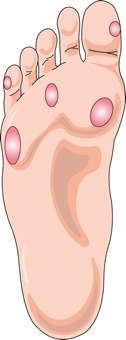-
Skin Conditions






Corns and calluses are extra cells made in a skin area that gets repeated rubbing or squeezing. The illustration on the right shows common sites on the bottom of the foot for corns and calluses.
Signs & Symptoms
-
•Corns are areas of dead skin on the tops or sides of the joints or on the skin between the toes.
-
•Calluses are patches of dead skin usually found on the balls or heels of the feet, on the hands, and on the knees. Calluses are thick and feel hard to the touch.
Causes
Footwear that fits poorly causes corns and calluses. So can activities that cause friction on the hands, knees, and feet.
Treatment
Self-care treats most cases. If not, a family doctor or foot doctor (podiatrist) can scrape the hardened tissue and peel away the corn with stronger solutions. Sometimes warts lie beneath corns and need to be treated, too.






Pointed, tight-fitting boots and shoes can cause corns. Wear footwear that doesn’t squeeze the toes together.

For Corns
-
•Don’t pick at corns. Don’t use toenail scissors, clippers, or any sharp tool to cut off corns.
-
•Don’t wear shoes that fit poorly or that squeeze your toes together.
-
•Soak your feet in warm water to soften the corn.
-
•Cover the corn with a protective, nonmedicated pad or bandage which you can buy at drug stores.
-
•If the outer layers of a corn have peeled away, apply a nonprescription liquid of 5 to 10% salicylic acid. Gently rub the corn off with cotton gauze.
-
•Ask a shoe repair person to sew a metatarsal bar onto your shoe to use when a corn is healing.
For Calluses
-
•Don’t try to cut a callus off.
-
•Soak your feet in warm water to soften the callus. Pat it dry.
-
•Rub the callus gently with a pumice stone.
-
•Cover calluses with protective pads. You can get these at drug stores.
-
•Don’t wear poorly fitting shoes or other sources of friction that may lead to calluses.
-
•Wear gloves for a hobby or work that puts pressure on your hands.
-
•Wear knee pads for activities that put pressure on your knees.
-
•Wear gloves when you garden or do other activities that put repeated pressure on your hands.
With a corn or callus, do you have any signs of infection, such as fever, swelling, redness, and/or pus?
With a corn or callus, do you have circulation problems or diabetes?
Do you have one or both of these problems even after using self-care measures?
-
•Continued or worse pain.
-
•No improvement after 2 to 3 weeks.
Self-Care / Prevention
{Note: Persons with diabetes should see a doctor for treatment for foot problems.}
Questions to Ask




Get more information from:
HealthyLearn® | www.HealthyLearn.com. Click on MedlinePlus®.
American Podiatric Medical Association 800.FOOTCARE (366.8227) | www.apma.org



Copyright © 2009, American Institute for Preventive Medicine. All rights reserved.